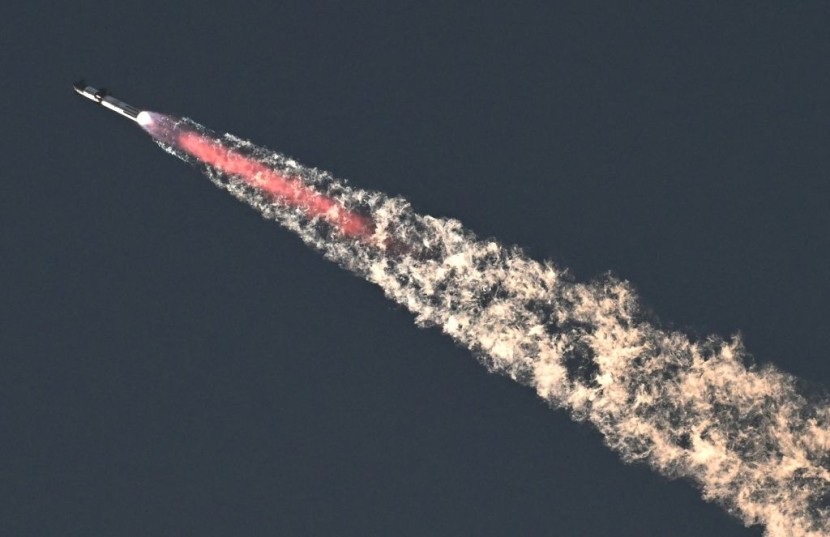SpaceX conducted its second-ever flight test of its Starship spacecraft and Super Heavy booster in the company's Starbase facility near Boca Chica, Texas at around 07:00 local time (13:00 UTC) on Saturday morning (November 18).
The Elon Musk-founded company intended to attempt a 90-minute near-orbital flight after lifting off on the Gulf Coast.
Just like its first attempt last April, Starship failed to achieve this milestone. However, SpaceX explained that its primary mission was to prove that the rocket stack could be separated in its staging phase using a technique called "hot staging," where the engines of the next stage of the rocket are fired up while the previous one is still running or is about to shut down, allowing a seamless transition in its flight.
According to Space.com, hot staging has been used in previous spacecrafts, such as NASA's Titan II and Saturn rockets, as well as several Russian rockets - including the Soyuz, which is still in operation to this day. It was also noted that Saturday's flight went higher and longer than the April flight test.
The launch was originally scheduled for Friday (November 17) but was pushed back by a day for a last-minute swap of flight control hardware.

From Liftoff to Loss of Spacecraft
Unlike last April's flight test, Starship's launch pad, which SpaceX and spaceflight enthusiasts call "Stage Zero," was duly protected by an improved water deluge system underneath the launch mount to protect crucial hardware in and around the launch pad. This also allowed the rocket to flawlessly lift off the pad at full power without getting damaged.
The first stage phase of Saturday's flight achieved maximum aerodynamic pressure (Max-Q) at a faster rate than the April attempt thanks to upgrades to the thrust vector control of its 39 Raptor engines - 33 in Super Heavy and 6 aboard Starship - in addition to the flight data provided during the previous launch.

Almost three minutes after liftoff, Starship successfully ignited its engines and separated from Super Heavy, which made a flip maneuver to slow it down before splashing down on the Gulf of Mexico. However, in its attempt to make what SpaceX called a "boost-back burn," some of the engines that were supposed to be reignited failed to do so, resulting in the activation of its autonomous flight termination system and subsequent disintegration of the rocket.
Meanwhile, Starship continued its course towards space and reached the Karman Line, the officially-recognized edge of space at 100 kilometers above sea level, at three-and-a-half minutes into the flight.
By the eighth minute, Starship's telemetry and guidance suddenly froze, indicating that the spacecraft's flight termination system activated before reaching its target altitude, in what SpaceX called a "rapid unscheduled disassembly."
Despite the failure, NASA Administrator Bill Nelson congratulated SpaceX regarding the development in the Starship program.
Congrats to the teams who made progress on today’s flight test.
— Bill Nelson (@SenBillNelson) November 18, 2023
Spaceflight is a bold adventure demanding a can-do spirit and daring innovation. Today’s test is an opportunity to learn—then fly again.
Together @NASA and @SpaceX will return humanity to the Moon, Mars & beyond. https://t.co/QGjwr45KM1
"Congrats to the teams who made progress on today's flight test," he said in a post on X, formerly Twitter. "Spaceflight is a bold adventure demanding a can-do spirit and daring innovation. Today's test is an opportunity to learn - then fly again."
Pros and Cons of Rapid Testing, Data-Gathering
SpaceX has been consistent in insisting on a rapid testing and iteration routine, especially in developing Starship, as a path to further hardware and technology development.
"We're going to take that data and improve the hot staging sequence and probably improve the hardware itself for the next flight," SpaceX quality engineering manager Kate Tice said during the live webcast on X, which Musk also owned.
This mindset has also been inculcated in its workhorse rockets, Falcon 9 and Falcon Heavy.
The firm also found it crucial to continue the rapid development path as NASA chose Starship as the lunar lander for its manned Artemis 3 mission, which was scheduled to carry humans to the Moon by late 2025 or early 2026, with further plans to use it to reach Mars in the future.
Nevertheless, the Federal Aviation Administration (FAA) would need to oversee SpaceX's internal investigation regarding the launch failure in order to give another permit to the company to prevent the mishaps during the launch from happening again.
In addition to spacecraft failures, SpaceX constantly faced intense scrutiny over its rapid development ethos over the years it has been operating.
On November 10, Reuters released an investigative piece highlighting its allegedly questionable workplace health and safety, as well as the increase in workplace injuries pertaining to Starship.
As a result of the article, at least three US lawmakers are calling for a greater scrutiny of the company's overall work ethic. The three lawmakers were identified as Representatives Zoe Lofgren (D-CA), Mark Takano (D-CA), and Donald Norcross (R-NJ).
On top of that is the pressure NASA has been facing in the wake of China's constant cadence of rocket launches, some of them involving humans in Earth orbit aboard the Chinese space station Tiangong.
"The clock is ticking," Space Capital managing partner and SpaceX investor Chad Anderson. "NASA has a timeline where they're trying to get to the moon, and this is their primary vehicle to do it. So SpaceX needs to deliver on a timeline."
Related Article : SpaceX Plans to Launch Next Starship Rocket This Week
© 2026 HNGN, All rights reserved. Do not reproduce without permission.








